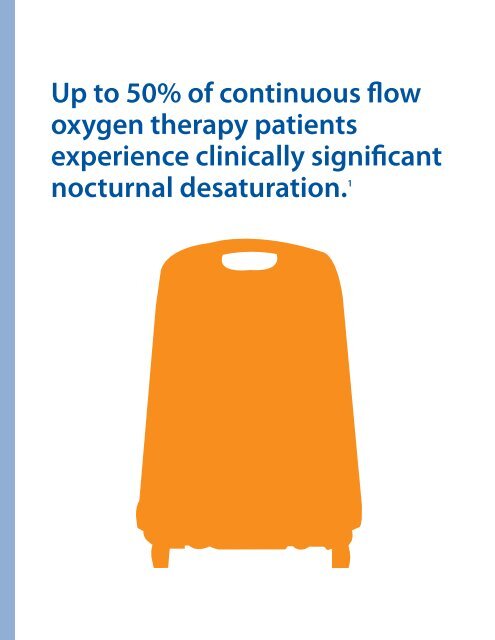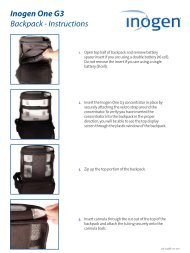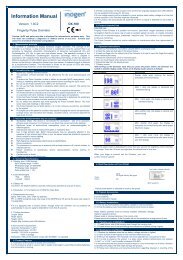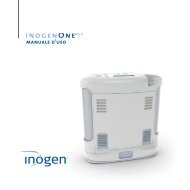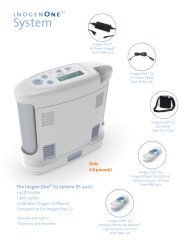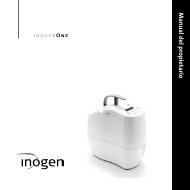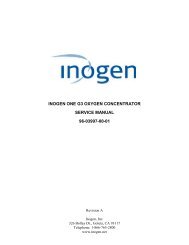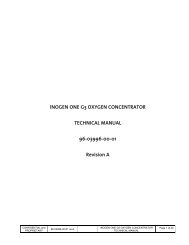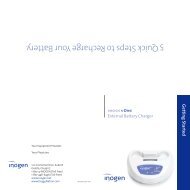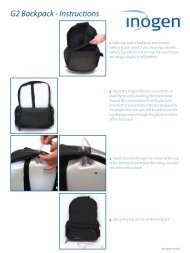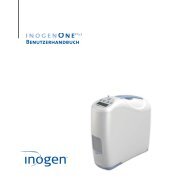Up to 50% of continuous flow oxygen therapy patients ... - Inogen One
Up to 50% of continuous flow oxygen therapy patients ... - Inogen One
Up to 50% of continuous flow oxygen therapy patients ... - Inogen One
You also want an ePaper? Increase the reach of your titles
YUMPU automatically turns print PDFs into web optimized ePapers that Google loves.
<strong>Up</strong> <strong>to</strong> <strong>50%</strong> <strong>of</strong> <strong>continuous</strong> <strong>flow</strong><br />
<strong>oxygen</strong> <strong>therapy</strong> <strong>patients</strong><br />
experience clinically significant<br />
nocturnal desaturation. 1
Continuous Flow Oxygen<br />
Delivery & Sleep<br />
A number <strong>of</strong> theories and studies are published surrounding long term <strong>oxygen</strong><br />
<strong>therapy</strong> (LTOT) during sleep. Many LTOT <strong>patients</strong> have been shown <strong>to</strong> experience<br />
clinically significant nocturnal desaturation. This holds true even for some LTOT<br />
users considered well managed on their prescribed LTOT setting while awake.<br />
While continous <strong>flow</strong> (CF) may have been traditionally seen as standard practice, it<br />
is not without flaws. Scientific data has revealed 30-<strong>50%</strong> <strong>of</strong> CF <strong>patients</strong> experience<br />
clinically significant desaturation during sleep 1 ; not a great track record for what<br />
some promote as the LTOT “gold standard”.<br />
The clinical deficiencies associated with CF have been known for years, as evidenced<br />
by the American Thoracic Society recommendation <strong>to</strong> increase nighttime CF <strong>oxygen</strong><br />
<strong>flow</strong>s by 1 lpm. This recommendation is intended <strong>to</strong> compensate for nocturnal<br />
desaturation due <strong>to</strong> decreased minute ventilation resulting from slower respira<strong>to</strong>ry<br />
rates and shallow breaths. Without increasing O 2 <strong>flow</strong>s at night, the data<br />
suggests that HME providers may expect 30-<strong>50%</strong> <strong>of</strong> their <strong>patients</strong> will experience<br />
some level <strong>of</strong> clinically significant nocturnal desaturation. 2,3,4<br />
CF Nocturnal O2 Delivery<br />
• Awake: RR (20) X CF (3 lpm) = 660ml O2 per minute<br />
• Asleep: RR (10) X CF (3 lpm) = 330ml O2 per minute<br />
(Assumes consistent inspira<strong>to</strong>ry time <strong>of</strong> 1 second)<br />
Most HMEs are unaware <strong>of</strong> these issues because it is not standard practice <strong>to</strong> perform<br />
overnight pulse oximetry on stable LTOT <strong>patients</strong>. This approach creates a false sense<br />
<strong>of</strong> clinical effectiveness in CF <strong>patients</strong>. This perception is based on healthcare dogma<br />
rather than evidenced-based research and outcomes.<br />
1 Plywaczewski R, et al. Incidence <strong>of</strong> nocturnal desaturation while breathing <strong>oxygen</strong> in COPD <strong>patients</strong> undergoing long-term <strong>oxygen</strong><br />
<strong>therapy</strong>. CHEST 2000; 117(3): 679-83<br />
2 Tarrega J, et al. Are daytime arterial blood gases a good reflection <strong>of</strong> nighttime gas exchange in <strong>patients</strong> on long-term <strong>oxygen</strong><br />
<strong>therapy</strong>? Respir Care 2002; 47(8): 882-6<br />
3 Sliwinski P, et al. The adequacy <strong>of</strong> <strong>oxygen</strong>ation in COPD <strong>patients</strong> undergoing long-term <strong>oxygen</strong> <strong>therapy</strong> assessed by pulse oximetry<br />
at home. Eur Respir J 1994;7(2): 274-278<br />
4 Plywaczewski R, et al. Behavior <strong>of</strong> arterial blood gas saturation at night in <strong>patients</strong> with obstructive ling diseases qualifying for home<br />
<strong>oxygen</strong> <strong>therapy</strong>. Pneumonol Alergol Pol 1997;65(7-8): 494-499
Evolution <strong>of</strong> Oxygen Delivery<br />
Pulse dose <strong>oxygen</strong> delivery (PDOD) is a logical extension and application <strong>of</strong> low <strong>flow</strong><br />
<strong>oxygen</strong> delivery. Although prescriptions are typically written in liters per minute<br />
(1 lpm), all low <strong>flow</strong> <strong>oxygen</strong> devices actually deliver a volume <strong>of</strong> <strong>oxygen</strong> <strong>to</strong> the patient.<br />
The volume <strong>of</strong> <strong>oxygen</strong> delivered is simply a result <strong>of</strong> the fixed <strong>flow</strong> <strong>of</strong> the gas over time.<br />
As an example, a patient prescribed 2 lpm <strong>of</strong> <strong>oxygen</strong> via nasal cannula does not<br />
actually inspire 2 full liters <strong>of</strong> <strong>oxygen</strong>. The net volume <strong>of</strong> the inspired <strong>oxygen</strong> delivered<br />
<strong>to</strong> a patient over the course <strong>of</strong> a minute is a product <strong>of</strong> the <strong>oxygen</strong> <strong>flow</strong> rate, patient’s<br />
respira<strong>to</strong>ry rate, inspira<strong>to</strong>ry time and the tidal volume minus ana<strong>to</strong>mical deadspace.<br />
<strong>Inogen</strong> <strong>One</strong> Nocturnal O2 Delivery<br />
• Fixed minute volume <strong>of</strong> O2 produced; bolus adjusted up or<br />
down based on RR. Adjusts for missed breaths, etc.<br />
• FMV* model <strong>of</strong> nocturnal O2 delivery<br />
• May deliver more nocturnal net O2 than CF<br />
• Awake: (3) setting RR (20) = 450ml per min OR 22.5ml per breath<br />
• Asleep: (3) setting RR (10) = 450ml per min OR 45ml per breath<br />
* FMV Fixed Minute Volume: Fixed amount <strong>of</strong> <strong>oxygen</strong> per minute. The bolus size varies based upon the <strong>patients</strong> breathing rate.<br />
(A lay explanation <strong>of</strong> this <strong>oxygen</strong> delivery concept is a water fountain):<br />
If an individual stands in front <strong>of</strong> a water fountain <strong>flow</strong>ing at 1 liter per minute, they<br />
don’t actually drink one full liter <strong>of</strong> water. The amount <strong>of</strong> water a person drinks is a<br />
product <strong>of</strong> the number <strong>of</strong> sips and the size <strong>of</strong> the sip. The same applies <strong>to</strong> <strong>continuous</strong><br />
<strong>flow</strong> <strong>oxygen</strong>; the net amount inspired is a combination <strong>of</strong> the <strong>flow</strong>rate, the number <strong>of</strong><br />
breaths and the size <strong>of</strong> the breath (with some additional variables).<br />
The clinical basis <strong>of</strong> effective PDOD relies on the assumption that the <strong>oxygen</strong><br />
participating in gas exchange in the lungs enters the airways quickly, during the<br />
first two-thirds <strong>of</strong> the inspira<strong>to</strong>ry cycle. Oxygen <strong>flow</strong>ing at the end <strong>of</strong> the inspiration,<br />
during exhalation and during the pause prior <strong>to</strong> the next inspiration is considered<br />
wasted, since it plays no role in gas exchange. Approximately one-third <strong>of</strong> a person’s<br />
inspiration is gas that remains in the larger airways, sinuses, nose and mouth,<br />
ana<strong>to</strong>mical deadspace.<br />
There are a few key elements associated with efficient PDOD technology, including<br />
bolus size, sensitivity, and bolus speed/delivery. PDOD promotes the theory that<br />
the earlier the <strong>oxygen</strong> bolus is delivered in<strong>to</strong> the inspira<strong>to</strong>ry cycle, the more efficient<br />
the <strong>oxygen</strong> delivery will be. Oxygen boluses delivered late in inspiration may be<br />
less effective in improving blood <strong>oxygen</strong> levels, as portions <strong>of</strong> the bolus may fall<br />
in<strong>to</strong> the ana<strong>to</strong>mical deadspace. Early work by Tiep and Lewis noted the efficiency<br />
<strong>of</strong> pulsed <strong>oxygen</strong> <strong>therapy</strong> can be improved by focusing the <strong>oxygen</strong> delivery <strong>to</strong><br />
early inspiration. 1<br />
1 Tiep BL, Lewis MI. “Oxygen conservation and <strong>oxygen</strong> conserving devices in chronic lung disease: A review.” Chest 1987 Aug;92(2):263-72 2
Inspira<strong>to</strong>ry Cycle & Bolus Delivery<br />
Exhale Inhale Exhale<br />
Continuous Flow Delivery<br />
Oxygen delivered during the first 2/3 <strong>of</strong><br />
the inspira<strong>to</strong>ry effort typically has the most<br />
direct affect on lung gas exchange. Oxygen<br />
delivered after this point tends <strong>to</strong> remain<br />
in ana<strong>to</strong>mical dead spaces, never reaching<br />
the lungs. More than 2/3 <strong>of</strong> <strong>continuous</strong> <strong>flow</strong><br />
<strong>oxygen</strong> is delivered when <strong>patients</strong> are not<br />
inhaling. This <strong>oxygen</strong> contributes little <strong>to</strong><br />
lung gas exchange.<br />
20 BPM<br />
Ana<strong>to</strong>mical<br />
Dead Space<br />
Useful O 2<br />
Continuous Flow O 2<br />
<strong>Inogen</strong> <strong>One</strong> Bolus Delivery<br />
Patented conserver technology contained<br />
within the <strong>Inogen</strong> <strong>One</strong> ensures <strong>oxygen</strong> is<br />
delivered within the first 400 milliseconds <strong>of</strong><br />
inspiration - where <strong>oxygen</strong> has the most effect<br />
on lung gas exchange. The <strong>Inogen</strong> <strong>One</strong><br />
conserver utilizes unparalleled triggering<br />
sensitivity <strong>to</strong> quickly detect a breath and<br />
deliver <strong>oxygen</strong> within this critical period. Less<br />
sensitive conservers may create lags in the<br />
onset <strong>of</strong> the bolus, resulting in portions <strong>of</strong> the<br />
delivered bolus arriving <strong>to</strong>o late, having less<br />
effect on lung gas exchange.<br />
20 BPM<br />
Exhale Inhale Exhale<br />
<strong>Inogen</strong> <strong>One</strong><br />
Bolus<br />
Useful O 2<br />
Ana<strong>to</strong>mical<br />
Dead Space<br />
<strong>Inogen</strong> <strong>One</strong> Nocturnal Bolus<br />
Delivery<br />
During periods <strong>of</strong> sleep, respira<strong>to</strong>ry rates<br />
typically decrease. The <strong>Inogen</strong> <strong>One</strong> actively<br />
responds <strong>to</strong> this changing physiology<br />
through its use <strong>of</strong> patented technology <strong>to</strong><br />
increase the bolus size. At 10 breaths per<br />
minute, the <strong>Inogen</strong> <strong>One</strong> delivers double<br />
the bolus size as it does when the breathing<br />
rate is 20 BPM.<br />
10 BPM<br />
Exhale Inhale Exhale<br />
<strong>Inogen</strong> <strong>One</strong><br />
Bolus<br />
Ana<strong>to</strong>mical<br />
Dead Space<br />
Useful O 2<br />
<strong>Inogen</strong> <strong>One</strong> – Continuous Flow<br />
Comparison<br />
Continuous <strong>flow</strong> <strong>oxygen</strong> delivery does not<br />
compensate for the amount <strong>of</strong> inspired<br />
<strong>oxygen</strong> during periods <strong>of</strong> decreased<br />
respiration (sleeping). The same volume is<br />
available, but at lower tidal volumes and in<br />
nocturnal breathing patterns, less <strong>oxygen</strong> is<br />
inspired. <strong>Inogen</strong> unders<strong>to</strong>od this deficit in<br />
<strong>continuous</strong> <strong>flow</strong> and designed the <strong>Inogen</strong><br />
<strong>One</strong> <strong>to</strong> deliver more <strong>oxygen</strong> per breath as<br />
frequency and depth <strong>of</strong> respiration decreases.<br />
10 BPM<br />
Exhale Inhale Exhale<br />
<strong>Inogen</strong> <strong>One</strong><br />
Bolus<br />
Useful O 2<br />
Ana<strong>to</strong>mical<br />
Dead Space<br />
Continuous Flow O 2
Designing an OCD for Sleeping<br />
Patients<br />
Unlike other PDOD devices, the <strong>Inogen</strong> <strong>One</strong> was specifically designed <strong>to</strong> deliver<br />
<strong>oxygen</strong> <strong>to</strong> sleeping <strong>patients</strong>. The sensitivity <strong>of</strong> 0.12 cm H 2 O makes the patented<br />
<strong>Inogen</strong> <strong>One</strong> conserver the most sensitive on the market and responsive <strong>to</strong><br />
shallow breathing.<br />
• The <strong>Inogen</strong> <strong>One</strong> Oxygen Conserving Device (OCD) is unique in that it is<br />
designed for use during all modes <strong>of</strong> activity, including sleep.<br />
• Patented circuit electronics don’t just produce an unprecedented level <strong>of</strong><br />
sensitivity <strong>to</strong> a user’s breathing, but also yields the ability <strong>to</strong> differentiate<br />
a breath from other variations in nasal cannula pressure.<br />
• Patented OCD control s<strong>of</strong>tware permits the device <strong>to</strong> be highly flexible<br />
<strong>to</strong> changing environments and meters <strong>oxygen</strong> delivery <strong>to</strong> promote increased<br />
<strong>oxygen</strong> delivery during sleep for most <strong>patients</strong>. As the patient's respira<strong>to</strong>ry<br />
rate decreases, bolus volume increases <strong>to</strong> ensure the prescribed volume<br />
<strong>of</strong> <strong>oxygen</strong> is delivered.<br />
The <strong>Inogen</strong> <strong>One</strong> Conserver: A New Level <strong>of</strong> Precision & Reliability<br />
<strong>Inogen</strong> <strong>One</strong><br />
Conserver 2<br />
Conserver 3<br />
Conserver 4<br />
Conserver 5<br />
Conserver 6<br />
Conserver 7<br />
0.00 0.20 0.40 0.60 0.80<br />
Conserver Sensitivity Measured in cmH2O<br />
Conserver Trigger Precision Data Source: McCoy, R., "A Guide <strong>to</strong> Understanding Oxygen Conserving Devices" 2003 and 2004<br />
4
"PDOD/DOD systems have been shown<br />
<strong>to</strong> be clinically effective in resting,<br />
exercising and sleeping <strong>patients</strong>."<br />
-AARC Clinical Practice Guidelines; 2007 Revision<br />
In contrast <strong>to</strong> the studies that identify deficiencies<br />
in traditional <strong>continuous</strong> <strong>flow</strong> <strong>oxygen</strong> use in sleeping<br />
<strong>patients</strong>, there are a series <strong>of</strong> favorable studies<br />
regarding the use <strong>of</strong> PDOD systems in sleeping<br />
LTOT <strong>patients</strong>.<br />
• A number <strong>of</strong> scientific studies have examined the<br />
clinical efficacy <strong>of</strong> PDOD devices among LTOT users<br />
during sleep. <strong>One</strong> <strong>of</strong> the largest is a hospital based<br />
study by Kerby, O’Donahue, et al that evaluated<br />
a PDOD against <strong>continuous</strong> <strong>flow</strong> <strong>oxygen</strong> in 100<br />
hospitalized, <strong>oxygen</strong> dependent <strong>patients</strong>. They<br />
concluded that a PDOD system produced clinically<br />
equivalent SaO 2 <strong>to</strong> that <strong>of</strong> <strong>continuous</strong> <strong>flow</strong> <strong>oxygen</strong><br />
during all activities, including sleep. 1<br />
• Cuvelier and associates used polysomnography <strong>to</strong><br />
study the nocturnal sleep <strong>to</strong>lerance <strong>of</strong> a demand<br />
PDOD in COPD <strong>patients</strong> with hypoxemia and concluded<br />
that a demand PDOD device does not induce any<br />
significant alteration in nocturnal neurophysiologic<br />
and ventila<strong>to</strong>ry pr<strong>of</strong>iles. 2<br />
• The American Association <strong>of</strong> Respira<strong>to</strong>ry Care Clinical<br />
Practice Guidelines now recognize the clinically efficacy<br />
<strong>of</strong> PDOD systems in resting, exercising and sleeping<br />
<strong>patients</strong>. 2,3<br />
1 Kerby GR, O’Donahue WJ, et al. “Clinical efficacy and cost benefit <strong>of</strong> pulse <strong>flow</strong><br />
<strong>oxygen</strong> in hospitalized <strong>patients</strong>.” Chest. 1990 Feb;97(2):369-72<br />
2 Cuvelier A, et al. “Nocturnal efficacy and <strong>to</strong>lerance <strong>of</strong> a demand <strong>oxygen</strong> delivery<br />
system in COPD <strong>patients</strong> with nocturnal hypoxemia.” Chest. 1999 July;116(7):22-29<br />
3 AARC Clinical Practice Guide Oxygen Therapy in the Home or Alternate Site<br />
Health Care Facility - 2007 Revision & <strong>Up</strong>date
<strong>Inogen</strong> has completed and published<br />
more clinical data surrounding the<br />
<strong>Inogen</strong> <strong>One</strong> than any other available<br />
<strong>oxygen</strong> <strong>therapy</strong> product.<br />
<strong>Inogen</strong> Specific Research<br />
1. Stegmaier JP. Chatburn RL, Lewarski JS. “Determination <strong>of</strong> an Appropriate Nocturnal<br />
Setting for a Portable Oxygen Concentra<strong>to</strong>r with Pulsed-Dosed Delivery.” Abstract.<br />
Respir Care November 2006;51(11): 1305.<br />
Summary: The purpose <strong>of</strong> this study was <strong>to</strong> determine if a single titration <strong>of</strong> <strong>oxygen</strong><br />
using a POC during ambulation/exercise would provide an appropriate setting for<br />
nocturnal use. The results suggested that an <strong>oxygen</strong> setting selection based on<br />
daytime ADL/ambulation appears <strong>to</strong> produce effective nocturnal <strong>oxygen</strong> <strong>therapy</strong><br />
as evidenced by a mean sleeping SpO 2 <strong>of</strong> 92% and no clinically significant<br />
desaturation.<br />
2. Chatburn, R, Lewarski J, McCoy R. “Nocturnal <strong>oxygen</strong>ation using a pulsed dose<br />
<strong>oxygen</strong> conserving device compared <strong>to</strong> <strong>continuous</strong> <strong>flow</strong> <strong>oxygen</strong>.”<br />
Respir Care March 2006;51(3): 252-256<br />
Summary: The study compared nocturnal <strong>oxygen</strong>ation with <strong>continuous</strong> <strong>flow</strong><br />
versus the <strong>Inogen</strong> <strong>One</strong> among a group <strong>of</strong> established LTOT users with chronic<br />
lung disease. The results demonstrate that when appropriately titrated, the<br />
<strong>Inogen</strong> <strong>One</strong> is essentially clinically equivalent <strong>to</strong> <strong>continuous</strong> <strong>flow</strong> <strong>oxygen</strong>.<br />
The study also suggests that daytime pulse dose titrations may be effective<br />
in determining nocturnal <strong>oxygen</strong>ation.<br />
3. Case, R, Hausmann R. “Use <strong>of</strong> a portable <strong>oxygen</strong> concentra<strong>to</strong>r with a fixed minute<br />
volume <strong>oxygen</strong> conserving device <strong>to</strong> deliver <strong>oxygen</strong> <strong>to</strong> exercising pulmonary<br />
rehabilitation <strong>patients</strong>.” Abstract.<br />
Respir Care November 2005;50(11):1510.<br />
Summary: The study concluded that the <strong>Inogen</strong> <strong>One</strong> was as clinically effective as<br />
<strong>continuous</strong> <strong>flow</strong> <strong>oxygen</strong> at maintaining target SpO 2 levels in high <strong>flow</strong> (4-5 lpm)<br />
<strong>oxygen</strong> users during intense exercise.<br />
4. McCoy, R, Lewarski, J. “A test for clinical equivalency: A portable concentra<strong>to</strong>r with<br />
integrated <strong>oxygen</strong>-conserving compared <strong>to</strong> <strong>continuous</strong> <strong>flow</strong> <strong>oxygen</strong> during<br />
nocturnal use.” Abstract.<br />
Respir Care November 2005; 51 (11):<br />
Summary: This study demonstrated the <strong>Inogen</strong> <strong>One</strong> TM POC was able <strong>to</strong> deliver<br />
adequate nocturnal <strong>oxygen</strong> <strong>therapy</strong> as evidenced by <strong>continuous</strong> SpO 2 moni<strong>to</strong>ring<br />
in 9 <strong>of</strong> 10 (90%) <strong>of</strong> <strong>patients</strong> studied. The resting daytime <strong>oxygen</strong> titration and the<br />
resultant SpO 2 appears <strong>to</strong> be reasonably effective method for determining an<br />
appropriate nocturnal <strong>oxygen</strong> setting.<br />
6
Why the <strong>Inogen</strong> <strong>One</strong>?<br />
The <strong>Inogen</strong> <strong>One</strong> was specifically designed as a single-source <strong>oxygen</strong> system.<br />
It is Medicare coded for use 24 hours a day, 7 days a week.<br />
The <strong>Inogen</strong> <strong>One</strong> is fully reimbursed by Medicare as both a stationary and portable<br />
system (E1390 for the stationary application and E1392 for the portable application).<br />
The <strong>Inogen</strong> <strong>One</strong> is clinically proven <strong>to</strong> provide the necessary <strong>oxygen</strong> for most<br />
ambula<strong>to</strong>ry <strong>patients</strong> during all phases <strong>of</strong> daily activity and during sleep.<br />
• The <strong>Inogen</strong> <strong>One</strong> is the only POC with published scientific studies<br />
validating its clinical efficacy during multiple clinical applications, including sleep<br />
The <strong>Inogen</strong> <strong>One</strong> simplifies your operations, patient set-ups, and patient use.<br />
• <strong>One</strong> unit for inven<strong>to</strong>ry, deployment, and tracking<br />
• No tracking or hydrostatic testing <strong>of</strong> cylinders - EVER!<br />
• A single, simple titration at set-up - just like any other device utilizing<br />
an <strong>oxygen</strong> conserver<br />
More than 30 commercial airlines permit the use <strong>of</strong> the <strong>Inogen</strong> <strong>One</strong>.<br />
The <strong>Inogen</strong> <strong>One</strong> delivers the cost savings <strong>of</strong> transfilling systems PLUS eliminates<br />
travel cost & coordination.<br />
• Transfilling systems do not remove the HME burden and expense <strong>of</strong><br />
travel coordination<br />
• Transfilling cylinders cannot be used during air travel or be refilled while in transit<br />
326 Bollay Drive<br />
Goleta, California 93117<br />
1.805.562-0515<br />
1.877.4-INOGEN (<strong>to</strong>ll free)<br />
1.877.446-6436 (<strong>to</strong>ll free)<br />
www.inogenone.com<br />
info@inogen.net<br />
MKT-0220A


